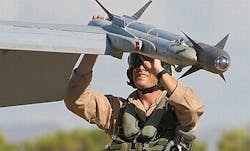Raytheon nets quarter-billion dollars in contracts for advanced air- and ship-launched missiles
Officials of the Naval Air Systems Command at Patuxent River Naval Air Station, Md., awarded a $233.1 million contract to the Raytheon Missile Systems segment in Tucson, Ariz., to build 485 AIM-9X Block II short-range air-to-air missiles for the U.S. Navy, Air Force, and foreign militaries.
In addition, the Navy awarded a separate $28.2 million contract modification to Raytheon Missile Systems for 774 AIM-9X inertial guidance retrofits and upgrades for the Navy and Air Force.
Raytheon's contract awards Wednesday, however, did not stop with those two AIM-9X missile awards. Officials of the Naval Sea Systems Command in Washington awarded a $14.1 million contract to Raytheon Integrated Defense Systems in Portsmouth, R.I., for life cycle support of the NATO Sea Sparrow Surface Missile System (NSSMS).
Related: Raytheon to provide AIM-9X missiles for US Navy
The total value of the three missile awards to Raytheon Wednesday is $265.3 million.
The Raytheon AIM-9X Block II Sidewinder is the latest version of the missile. The initial version of the AIM 9X entered service in November 2003 on the Air Force F-15C jet fighter and on the Navy F/A-18C strike fighter. The initial AIM 9X version featured an imaging infrared focal plane array (FPA) seeker with 90-degree off-boresight capability, compatibility with helmet-mounted displays, and a 3-D thrust-vectoring control (TVC) system to enhance turn capability.
An advanced helmet-mounted display can enable the pilot to lock the AIM-9X missile's seeker on its target simply by looking at the target. The missile has lower aerodynamic drag that its predecessors for improved range and speed. The AIM-9X also includes an internal cooling system and an electronic safe-and-arm device to reduce the missile's minimum range, as well as a reprogrammable infrared counter-countermeasures (IRCCM) capability.
The IRCCM capability working together with the missile's infrared focal plan array seeker enhance the weapon's ability to acquire targets below the aircraft in electro-optical clutter and defeat advanced countermeasures.
Related: Pentagon eyes AIM-9X-2 Sidewinder air-to-air missile sale for Netherlands F-16 jet fighters
The AIM-9X Block II, meanwhile, has lock-on after launch capability with a datalink, so the missile can be launched and then directed to its target by advanced aircraft such as the F-35 and F-22.
The AIM-9X Block II adds a redesigned fuze and a digital ignition safety device that enhances ground handling and in-flight safety. The Block II variant also features updated electronics that enable lock-on-after-launch capability using a new weapon datalink to support beyond visual range engagements.
The NATO Sea Sparrow is a ship-based short-range anti-aircraft and anti-missile weapon with enhanced speed and advanced seeker, and can be fired from the vertical launch systems of modern warships.
The largest of the three contracts awarded to Raytheon on Wednesday calls for Raytheon to provide 161 AIM-9X Block II missiles to the Navy, 158 to the Air Force, 20 to Singapore, 28 to The Netherlands, one to Kuwait, and 117 to Turkey.
Related: BAE Systems to produce Evolved Sea Sparrow Missile components
The contract also calls for Raytheon to build 132 AIM-9X Block II training missiles. Of these, 47 are tor the Navy, 55 are for the Air Force, 20 are for The Netherlands, eight are for Singapore, and two are for Morocco.
In addition, Raytheon will provide 27 special air training missiles. Of these, 13 are for the Navy, 12 for the Air Force, and two for The Netherlands. The contract includes missile containers spare advanced optical target detectors, spare guidance kits, and captive air training missile guidance kits.
For more information contact Raytheon Missile Systems online at www.raytheon.com, Raytheon Integrated Defense Systems at www.raytheon.com, Naval Air Systems Command at www.navair.navy.mil, or Naval Sea Systems Command at www.navsea.navy.mil.
